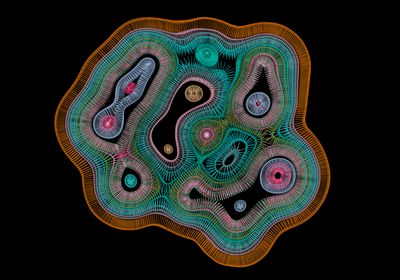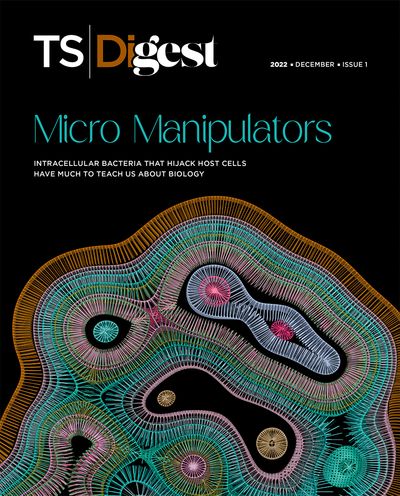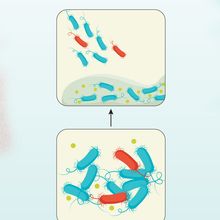ABOVE: © ISTOCK.COM, dani3315
As a grad student in cell biology, Shaeri Mukherjee was always on the lookout for new ways to fiddle with cells’ internal structures. It was the early 2000s, and Mukherjee was working in Dennis Shields’s lab at Albert Einstein College of Medicine, studying how cells organize the internal transport of proteins and other cargo. She was particularly interested in the Golgi apparatus, a cluster of membrane-bound compartments that help coordinate this trafficking, and spent much of her time manipulating the organelle’s activity to try to better understand how it works. Genetics methods could slow down or alter the organelle’s structure in days; certain pharmacological agents made it disintegrate in less than half an hour. But in 2008, Mukherjee stumbled across a new and much faster way to cause intracellular mayhem.
The technique came from a paper by Craig Roy at Yale University School of Medicine. Roy’s team had found that “this protein called AnkX, when microinjected into cells—even at picomole levels—could cause the entire Golgi to fragment in, like, five minutes,” Mukherjee says. Remarkably, AnkX hadn’t been made by cell biologists or a pharmaceutical company. Rather, it was produced by a tiny intracellular bacterium known as Legionella pneumophila, the pathogen behind a serious lung infection called Legionnaire’s disease. For Mukherjee, the paper was a revelation: not only did it identify the fastest way yet to target Golgi biology, it suggested that scientists could use intracellular bacteria “as a lens to understand basic processes inside the cell.”
Intrigued by this powerful little microbe, Mukherjee applied for a postdoc in Roy’s lab, where she would study in detail how Legionella attacks human cells from the inside. She learned that researchers had identified more than 300 Legionella peptides that mimic host proteins or otherwise hijack existing cellular pathways to the bacterium’s advantage. And she gained a new appreciation for the myriad other types of intracellular bacteria, a diverse group that includes many medically significant pathogens such as Salmonella, Listeria, and Chlamydia, as well as the causative agents of tuberculosis and leprosy. (See Bug Box below.)
Studying bacterial interactions with actin is still throwing up new mysteries.
These microbes all enjoy at least part of their lives shielded from the onslaught of white blood cells, antibodies, and other immune defenses that the body launches against pathogens that live outside of host cells. As a trade-off, they have had to come up with ways to bypass a cell’s internal immune system, navigate the complicated, busy environment of the cell cytoplasm, and ultimately escape that environment to infect other cells—becoming tiny maestros of manipulation in the process.
Research on how intracellular bacteria take control of their hosts is not only informing scientists about how these microbes cause disease, but revealing secrets of mammalian biology, says Mukherjee, who now heads up a lab at the University of California (UC), San Francisco. These bugs have a knack for pinpointing critical cell functions, she says, adding fondly that Legionella is continuing to help her explore how eukaryotic cells work. “It’s an excellent cell biologist.”
BUG BOXIntracellular bacteria vary considerably in how dependent they are on their hosts. So-called facultative intracellular bacteria such as Listeria monocytogenes and Legionella pneumophila do not need to be inside a host cell to reproduce. By contrast, obligate intracellular bacteria such as Chlamydia trachomatis and Mycobacterium leprae do, and this trait makes them a challenge to culture and study in the lab. Obligate intracellular pathogens will often have reduced genomes compared to the facultative variety, a genetic tendency that is reflective of their more limited lifestyle. |
Bacteria hijack the actin cytoskeleton to build tails, hitch rides
In the late 1980s, bacteriologist Daniel Portnoy visited actin expert Lewis Tilney at the University of Pennsylvania to discuss a new research idea. Or as Tilney later relayed the experience to the Journal of Cell Biology: “Portnoy crashed a department picnic and insisted I look at his damn Listeria.”
By then it was known that Listeria infects cells such as macrophages—motile human immune cells that engulf pathogens and cellular debris—by being taken up into vacuoles and breaking out of those vacuoles into the cytoplasm. Researchers had also described the bacteria quickly spreading among neighboring cells. But Portnoy, who joined UPenn’s medical school in 1988, had found he could block this cell-to-cell spread by chemically inhibiting the polymerization of actin, a protein that cells use to build an intracellular cytoskeleton to aid cell motility, division, and other important processes. Intrigued, Tilney took on the project, and together the pair showed that after breaking out of the vacuole, Listeria managed, somehow, to construct its own tail-like structure out of actin filaments.
The resulting little Listeria “comet,” as the pair called it, used its new actin motility to whiz around the cytoplasm and eventually hurl itself at the plasma membrane, causing a protrusion that extended into a neighboring macrophage. This protrusion got engulfed by the recipient cell to form a vacuole, and Listeria then simply had to muscle out of its new compartment to complete infection. (See illustration.) Portnoy and Tilney described the whole process in a 1989 paper, observing that their findings “should be important to those concerned with stages in the cell biology of infection by parasites and . . . exciting to cell biologists who want to know how actin filaments become organized in cells.”
Many other scientists have since joined in the study of Listeria’s actin co-option. Pascale Cossart, a microbiologist who was studying Listeria virulence at the Pasteur Institute in the 1990s, soon identified a bacterial protein, ActA, that the microbes require to build their tails. Cell biologist Matthew Welch, then at UC San Francisco, and colleagues next isolated a host cell protein complex, Arp2/3, that is also necessary for Listeria to become motile. The team found that Listeria’s ActA was recruiting the Arp2/3 complex to the bacterial cell surface, and this was what was initiating actin polymerization—confirming that the bacterium was co-opting the cell’s own machinery and raw materials for personal use. The work hinted that eukaryotes might possess their own Arp2/3-activating proteins, and sure enough, researchers have since described a whole family of host actin nucleation–promoting factors, which Listeria’s ActA successfully mimics.
“If you slow down the leading ribosome, the ribosome after it goes and hits it . . . just like a pile-up in a freeway.”
—Shaeri Mukherjee, UC San Francisco
A number of other intracellular bacterial taxa—including Shigella, Rickettsia, Mycobacterium, and Burkholderia—have been observed constructing their own actin tails, often by hijacking Arp2/3. And while many take a Listeria-like approach to infecting new hosts (shoving into neighbors and being taken into vacuoles), it’s not the only way. Welch, now at UC Berkeley, and grad student Nora Kostow recently used live cell imaging and other technologies to study Burkholderia thailandensis, which spreads by causing neighboring cells to fuse. The bacteria essentially expand “the available environment for them to grow,” says Welch. “They can do that repeatedly, so you can get hundreds of cells fusing together in some cases.” He and Kostow showed that actin-powered B. thailandensis achieves this spread by pushing on the plasma membrane to create protrusions that, rather than create vacuoles in a neighboring cell, cause those two cells to become one. This melding appears to be dependent on specific proteins secreted by the bacterium as it forms the protrusions—an insight that could help cell biologists understand cell fusion more generally, the authors write in their paper.
Studying variations on these bacterial interactions with actin is still throwing up new mysteries. While investigating Mycobacterium marinum, a close relative of M. tuberculosis, Welch and postdoc Norbert Hill recently found that microbial proteins could confer actin motility not just on the bacterium, but also on another sort of intracellular object: lipid droplets. It’s not yet clear how this lipid movement relates to Mycobacterium’s presence, “but it’s tempting to speculate that it could happen during infection,” either to the bacterium’s benefit or as some cellular response to infection, Welch says. Several lines of research suggest that Mycobacterium species might use lipid droplets as a source of chemical energy, among other things, he adds, so perhaps it’s in the bacterium’s interest to have those droplets whizzing around too.
Listeria gets its host to build it an actin tailSome intracellular bacteria use the host cell’s actin supplies to build their own transport system. The foodborne pathogen Listeria monocytogenes infects immune cells called macrophages by being taken up into a vacuole (1) before entering the cytoplasm where it lives and replicates (2). There, it uses a protein called ActA to recruit the host cell’s actin polymerization machinery to construct a tail of actin filaments behind it (3). This process gives the bacterium a means to propel itself around and lets it push on the host cell membrane, forming protrusions into neighboring cells (4). Those neighbors take up these protrusions as vacuoles, from which Listeria escapes to access the cytoplasm and begin the cycle again (5). 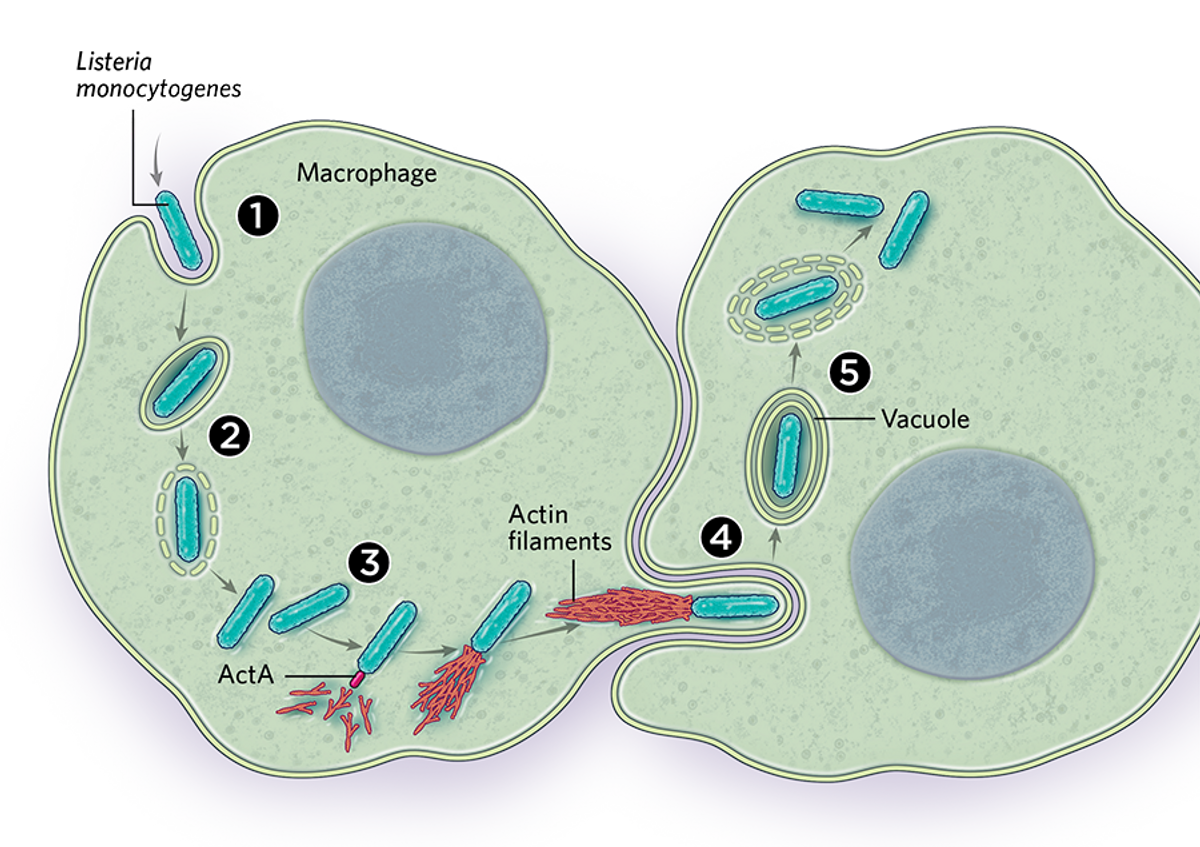 © scott leighton |
Microbes take control of intracellular membranes for various ends
The cytoplasm isn’t for everyone. While bugs such as Listeria gain access to building materials like actin, they also have to dodge the cell’s immune defenses and survive a chemical environment they have little control over. Some bacteria avoid these inconveniences by instead occupying organelle-like compartments that separate them from the rest of the cell. These microbes can and do still interact with actin—some secrete proteins that cause rearrangements in the cell cytoskeleton to help take up the bacterium from outside, or to form highway-like protrusions into other cells, for example. But many have also mastered a different sort of target that allows them to wield control over the rest of the cell without venturing into the cytoplasm: namely, lipid membranes.
It was Legionella’s ability to take over and even mimic intracellular membranes that occupied Mukherjee during her postdoc at Yale. It turned out that AnkX, the same microbial protein that had caused the Golgi apparatus to disintegrate, was part of a larger scheme to coerce the host into preparing a bacteria-friendly compartment. Legionella was using AnkX, among other peptides, to target host enzymes known as Rab GTPases, which sit on the surface of organelles such as the endoplasmic reticulum and the Golgi apparatus and regulate the trafficking of protein cargo around the cell. (See illustration.)
Specifically, Mukherjee, Roy, and colleagues showed that by making an unusual type of modification known as phosphocholination to one of the cell’s Rab proteins, Legionella was able to cause a “massive and quick collapse of the [host] trafficking pathway,” Mukherjee says. This was in addition to its recruitment of that same Rab protein through a separate mechanism to the surface of its own intracellular compartment, converting its hideaway into something resembling the endoplasmic reticulum. Labs including Roy’s have since showed how this membrane conversion is part of a process that preps Legionella’s compartment for bacterial replication. Similar membrane-copying or -hijacking processes have been described in other microbes, too. The sexually transmitted pathogen Chlamydia trachomatis, for example, conspires to reorganize Golgi membranes around its intracellular compartment, while rerouting the organelle’s vesicles to itself as a source of lipids.
Some bacteria launch a well-choreographed effort to manipulate what a cell can and can’t make at different times during infection.
Other intracellular bugs have found different ways to mess with a cell’s membranes. The single-cell parasite Toxoplasma gondii, which the Centers for Disease Control and Prevention estimates currently infects more than 40 million people in the US alone, survives in an intracellular vacuole, from which it deploys proteins to subvert host cell function. Researchers observed decades ago that the T. gondii vacuoles, like several types of bacterial compartments, often become surrounded by mitochondria—a phenomenon that’s now thought to be related to a cellular anti-pathogen response, says Lena Pernas, a parasitologist-turned-cell-biologist at the Max Planck Institute for the Biology of Ageing in Cologne, Germany.
Pernas’s team recently found that T. gondii is able to subvert and exploit this mitochondrial mobbing by secreting a protein that causes the organelles to cast off the outer of their two membranes. “We’re not sure exactly how that happens . . . and this is the subject of ongoing work in the lab,” Pernas says. But her team’s experiments do suggest that the shedding behavior is a natural mitochondrial response to outer membrane stress that can occur even in uninfected cells, and that T. gondii has hijacked this process—perhaps by mimicking a host protein that normally triggers the reaction. Whether other pathogens exploit this or related pathways remains to be seen, although some researchers have noted that at least one of the mitochondrial proteins mentioned in Pernas’s study also seems to be targeted by viruses such as SARS-CoV-2.
It wouldn’t be surprising to discover new types of membrane manipulation, Mukherjee says, adding that the behavior offers a versatile way to exert influence over everything from cell division to the intracellular positioning of organelles and even pathogens themselves. “That’s why various bacteria target various membranes inside the cell.”
Legionella takes control of host membranesSome intracellular bacteria, such as Legionella pneumophila, inhabit membrane-bound compartments inside host cells (1). Once there, the microbes typically interact with host membranes and secrete so-called effector proteins that help the microbes wield control over them (2). Legionella in particular interacts with the Golgi apparatus and the endoplasmic reticulum, pilfering some of the organelles’ proteins and rerouting their vesicular traffic. Later, the newly formed membranes become studded with ribosomes (3) that may help the bacterium make certain host proteins—or could simply be a byproduct of the membrane’s ER-like identity. Legionella replicates inside this compartment before bursting out of the cell (4). 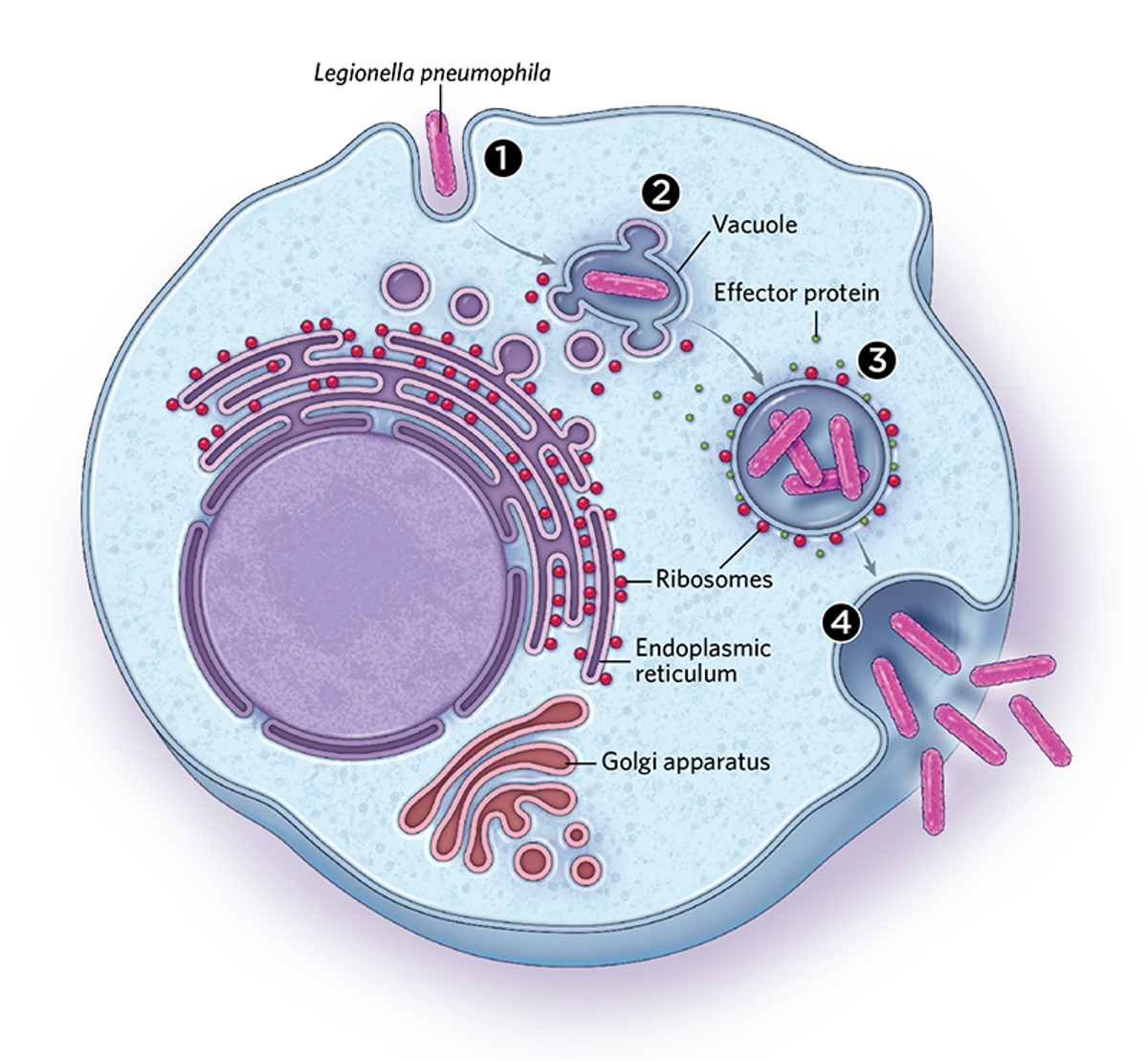 © scott leighton |
Bacteria reprogram their host cells to do their bidding
Intracellular bacteria and other parasites carry their own protein-making machinery, so it might sometimes make sense for them to shut down or pause most of the host’s protein production. “The host will most likely make proteins that are deleterious for the bacteria,” explains Mukherjee, who recently showed that Legionella is able to block protein synthesis by targeting a host peptide involved in protein folding. On the other hand, an intracellular bacterium doesn’t want to kill off its host before it’s ready to move on, or to miss out on the opportunity to get the host to perform energy-intensive tasks on its behalf.
Faced with these trade-offs, some bacteria launch a well-choreographed effort to manipulate what a cell can and can’t make at different times during infection. For example, Mukherjee and colleagues recently identified a tRNA-mimicking toxin secreted by Legionella that stalls the movement of host ribosomes along RNA, causing collisions. “If you slow down the leading ribosome, the ribosome after it goes and hits it . . . just like a pile-up in a freeway.” This sets off a cascade of events in the cell, the researchers found, including large-scale alterations to gene expression that allow just a few key transcripts to bypass the traffic jam and get translated into proteins. The response leads to controlled cell death, which is good news for Legionella: the host breaks open, releasing the bacteria to go on to infect other cells.10 It’s yet another case of a microbe teaching biologists about how cells work, says Mukherjee, who described the research in a preprint on bioRxiv—the team only discovered the genetic response to ribosome collisions thanks to Legionella’s ability to target that pathway.
Some intracellular bacteria appear to take a different tack: instead of prompting cells to self-destruct, they can cause changes in their host’s cell type. The University of Edinburgh’s Anura Rambukkana has studied reprogramming by Mycobacterium leprae, which causes leprosy. These bacteria infect Schwann cells, glial cells that surround neurons and help develop and repair peripheral nerves. Infection typically triggers widespread neurological injury and, eventually, loss of sensitivity to pain or touch in affected limbs. But in 2013, Rambukkana and colleagues reported results from a series of in vitro and mouse experiments that suggested the bacterium was first hijacking their hosts’ gene expression, apparently reprogramming Schwann cells back into a stem-cell-like state. (See illustration.)
This tweaking of gene expression seems to aid M. leprae’s spread in at least two ways. First, altered cells can go on to differentiate into other cell types, including muscle cells, says Rambukkana, potentially seeding the bacteria in these other tissues. Second, reprogrammed cells attract macrophages, which themselves can pick up the infection and spread it to other tissues. The team is currently working to understand more about the mechanisms underlying this cellular rewiring, as well as exploring potential therapeutic applications of the phenomenon. For example, studying the factors the bacteria use to reprogram cell state might offer new techniques for regenerative medicine, Rambukkana says. The team is currently testing some of these principles in nine-banded armadillos (Dasypus novemcinctus)—not an ideal model for human biology, but one of M. leprae’s few natural hosts other than humans.
Cossart, now a visiting scientist at EMBL Heidelberg in Germany, calls the work on Schwann cell reprogramming a “very interesting” line of research and notes that these kinds of findings highlight just how varied intracellular pathogens are in their attempts to subvert cell function. “There are different types of result with different types of pathogens,” she notes, adding that in addition to studying species differences, researchers should dig into variation among different strains of bacteria and under different conditions if they want to understand the biological consequences of infection. It’s only relatively recently, for example, that scientists have started to consider intracellular bacteria’s interactions—direct or indirect—with the microbiome of the organisms they infect, a research area that Cossart says deserves more attention.
In many cases, though, the wider impact of research using intracellular microbes may be hard to estimate in advance, says Mukherjee, noting that tools such as CRISPR grew out of basic research—in that case, on a system bacteria use to defend themselves from infection by viruses. “We are basic scientists, we want to study fundamental processes,” she says. That work can “have an impact down the road.”
Mycobacterium leprae reverts its host to a stem cell–like stateMycobacterium leprae, which causes leprosy, takes cell reprogramming to an extreme by reverting its Schwann cell host into a stem cell–like state (1). These cells can then redifferentiate into muscle cells, for example, perhaps spreading the bacterium to other tissues (2). The reprogrammed cells can also pass the infection on to macrophages, which then form structures known as granulomas before going on to spread the infection themselves (3). 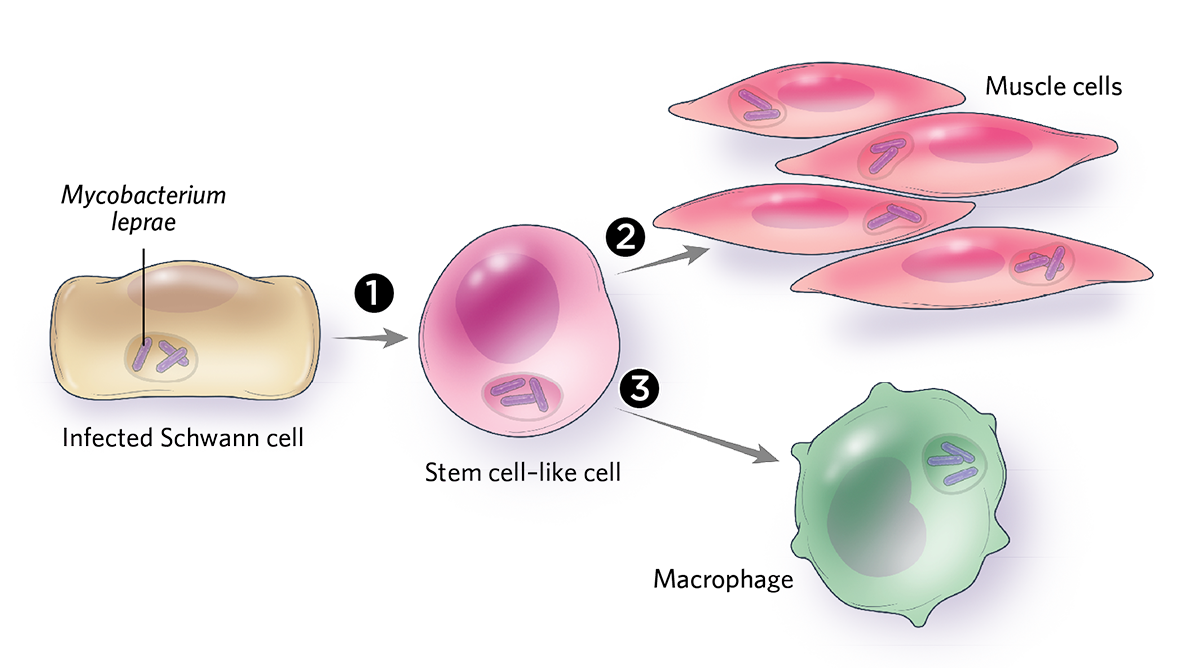 © scott leighton |
